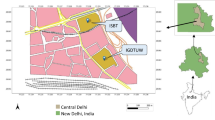Abstract
Haze from urban sites in Beijing was collected with a self-assembled electrostatic dust collector. The sizes and morphologies, thermal properties, and compositions of the particles in the haze were characterized by scanning electronic microscopy (SEM), differential scanning calorimetry (DSC), thermal gravimetric analysis (TGA), and X-ray photoelectric spectroscopy (XPS), respectively. Based on these results, the causes and pollutant sources of the chemicals in the haze were analyzed, and some countermeasures were further advanced to reduce the related pollutant sources.

ᅟ








Similar content being viewed by others
References
Boreson J, Dillner AM, Peccia J (2004) Correlating bioaerosol load with PM2.5 and PM10cf concentrations: a comparison between natural desert and urban-fringe aerosols. Atmos Environ 38:6029–6041
Brody H, Grayson M, Miller K (2014) Breathing trouble. Nature 513:s14
Brook RD, Franklin B, Cascio W, Hong Y, Howard G, Lipsett M, Luepker R, Mittleman M, Samet J, Smith SCJ, Tager I (2004) Air pollution and cardiovascular disease: a statement for healthcare professionals from the expert panel on population and prevention science of the American Heart Association. Circulation 109:2655–2671
Cao C, Jiang W, Wang B, Fang J, Lang J, Tian G, Jiang J, ZT F (2014) Inhalable microorganisms in Beijing’s PM2.5 and PM10 pollutants during a severe smog event. Environ Sci Technol 48:1499–1507
Gao M, Qiu T, Jia R, Han M, Song Y, Wang X (2015) Concentration and size distribution of viable bioaerosols during non-haze and haze days in Beijing. Environ Sci Pollut Res 22:4359–4368
Guo S, Hu M, Zamora ML, Peng JF, Shang DJ, Zheng J, Du ZF, Wu Z, Shao M, Zeng LM (2014) Elucidating severe urban haze formation in China. Proc Natl Acad Sci U S A 111:17373–17378
He H, Wang Y, Ma Q, Ma J, Chu B, Ji D, Tang G, Liu C, Zhang H, Hao J (2014) Mineral dust and NOx promote the conversion of SO2 to sulfate in heavy pollution days. Sci Rep 4:4172
Hu D, Jiang J (2013) A study of smog issues and PM2.5 pollutant control strategies in China. J Environ Prot 4:746–752
Huang R et al (2014) High secondary aerosol contribution to particulate pollution during haze events in China. Nature 514:218–222
Liu S, Xie TH, Chen Z, Wu JT (2009) Highly active V-TiO2 for photocatalytic degradation of methyl orange. Appl Surf Sci 255:8587–8592
Liu XG, Li J, Qu Y, Han T, Hou L, Gu J, Chen C, Yang Y, Liu X, Yang T, Zhang Y, Tian H, Hu M (2013) Formation and evolution mechanism of regional haze: a case study in the megacity Beijing, China. Atmos Chem Phys 13:4501–4514
Ma J, Xu X, Zhao C, Yan P (2012) A review of atmospheric chemistry research in China: photochemical smog, haze pollution, and gas-aerosol interactions. Adv Atmos Sci 29:1006–1026
Song Y, Liu F, Sun B (2005a) “Preparation, characterization, and application of thin film composite nanofiltration membranes.”. J Appl Polym Sci 95(5):1251–1256
Song Y, Sun P, Henry LL, Sun B (2005b) “Mechanism for structure and performance controlled preparation of thin film composite membrane via interfacial polymerization.”. J Membr Sci 251(1–2):67–72
Sun Z, Mu Y, Liu Y, Shao L (2013) A comparison study on airborne particles during haze days and non-haze days in Beijing. Sci Total Environ 456–457:1–8
Tie X, Wu D, Brasseur G (2009) Lung cancer mortality and exposure to atmospheric aerosol particles in Guangzhou, China. Atmos Environ 43:2375–2377
Topsoe H (2007) The role of Co-Mo-S type structures in hydrotreating catalysts. Applied catalysis a-general 322:3–8
Yu X, Zhu B, Yin Y, Yang J, Li Y, Bu X (2011) A comparative analysis of aerosol properties in dust and haze-fog days in a Chinese urban region. Atmos Res 99:241–247
Zhang JJ, Cui MM, Fan D, Zhang DS, Lian HX, Yin ZY, Li J (2015) Relationship between haze and acute cardiovascular, cerebrovascular, and respiratory diseases in Beijing. Environ Sci Pollut Res Int 22:3920–3925
Zhang Z, Wang J, Chen L, Chen X, Sun G, Zhong N, Kan H, Lu W (2014) Impact of haze and air pollution-related hazards on hospital admissions in Guangzhou, China. Environ Sci Pollut Res Int 21:4236–4244
Zhao XJ, Zhang XL, Xu XF, Xu J, Meng M, Pu WW (2009) Seasonal and diurnal variations of ambient PM2.5 concentration in urban and rural environments in Beijing. Atmos Environ 43:2893–2900
Acknowledgments
This work was supported by the Fundamental Research Funds for the Central Universities (FRF-BR-15-027A, FRF-BR-14-001B) and NSFC (grant no. 51371018).
Authors’ contributions
Y.S. conceived the idea and designed the project. J.Z. and H.W. provided the instrument and collected the haze. Y.S. and J.W. did the XPS, TGA, DSC measurements and SEM characterization. All authors took part in the data analysis and the paper writing. There is no financial conflict among authors.
Author information
Authors and Affiliations
Corresponding author
Additional information
Responsible editor: Gerhard Lammel
Electronic supplementary material
Below is the link to the electronic supplementary material.
ESM 1
(DOCX 1255 kb)
Rights and permissions
About this article
Cite this article
Wang, J., Song, Y., Zuo, J. et al. Compositions and pollutant sources of haze in Beijing urban sites. Environ Sci Pollut Res 23, 8827–8836 (2016). https://doi.org/10.1007/s11356-016-6127-1
Received:
Accepted:
Published:
Issue Date:
DOI: https://doi.org/10.1007/s11356-016-6127-1




